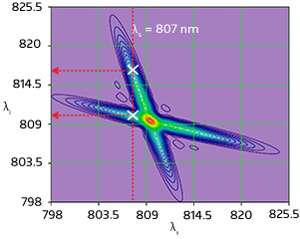Ultrafast laser pulses and precisely cut optical crystals could control quantum properties of light

Quantum optics scientists and engineers are striving to harness the properties of small packets of light called photons to improve communications and computational devices. Vital to these efforts is an invisible connection between pairs of photons; understanding this effect is therefore crucial. By mapping the connections, researchers at the A*STAR Data Storage Institute, Singapore, and in Russia have shown that the properties of each photon in a pair, which were created in the same time and place, are governed by statistics. The maps could aid future quantum optics engineering efforts.
Many of the early experiments studying the quantum properties of photons used a process called spontaneous parametric down-conversion (SPDC). In SPDC, a photon striking the front of a slab of a crystalline material with specific nonlinear optical properties decays into two lower-energy photons. These photons, referred to as the signal and the idler, are 'entangled'—intimately coupled in a way that classical physics cannot describe.
The properties of the photons are determined not when they leave the back of the slab, but when a measurement is made on one of them. At this moment, the properties of the other photon are immediately determined, even though the two may be separated by a long distance.
The situation is more complicated, however, when short laser pulses are used to control the timing of the process. The SPDC emission from the back of the slab consists of photon pairs, or biphotons, across a broad spectrum of wavelengths. A full understanding of the strength of the connection between any two photons in this complex emission profile is important for optimizing the entangled-photon source, and thus improving optical tests of quantum mechanics.
Dmitry Kalashnikov and co-workers fully plotted the correlations of SPDC-generated photons by carefully tailoring the properties of a nonlinear crystal of ?-barium borate and the parameters of the ultrafast laser exciting it. "We fixed the frequency of the signal photon and scanned the frequency of the idler photon to find the maximum correlation between the two," explains Kalashnikov (see image). "We found that the maximum of the correlation is reached at two distinct frequencies." This unusual 'double-peak' structure occurs only under certain conditions—when the crystal is thick enough (5 millimeters) and the exciting laser pulse length is short (less than 110 femtoseconds).
"The effect is harmful as it decreases the quality of entanglement," says Kalashnikov. "Scientists and engineers will have to pay attention to this when constructing their quantum optics setups and devices in the future."
More information: Kalashnikov, D. A., Fedorov, M. V. & Krivitsky, L. A. Experimental observation of double-peak structure of coincidence spectra in ultrafast spontaneous parametric down-conversion, Physical Review A 87, 013803 (2013). dx.doi.org/10.1103/PhysRevA.87.013803
Journal information: Physical Review A



















